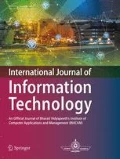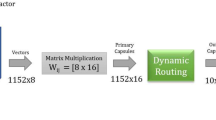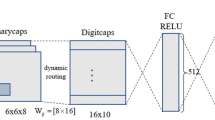Abstract
Useful real-life images meant for computer vision applications appear in complex forms with varied backgrounds. Convolutional neural networks with their invariance outperforms capsule networks (CapsNets) on such images. Recent research to improve the accuracy of CapsNets on complex images such as CIFAR10 involves the increase in depth of the networks. However, smaller architectures with efficient feature extractors can perform comparatively well with additional advantages of having less computational cost, reduced risk of overfitting, increased suitability for deployment on devices with smaller memories, and enhanced feasibility to perform distributed training across servers and in the cloud. This paper, therefore, proposes a shallow CapsNet based on dynamic routing with a custom squashing function and normalizer to gain all of these advantages. The model is evaluated on three publicly available datasets; fashion-MNIST, CIFAR-10, and tomato datasets. Experimental results show that the proposed model outperforms the original CapsNet by generating fewer parameters and performing comparably well in terms of accuracy with some state-of-the-art multi-lane and ensemble capsule network models.






Similar content being viewed by others
Availability of data and material
Freely available online from the cited sources.
Code availability
References
Sabour S, Frosst N, Hinton GE (2017) Dynamic routing between capsules. In: 31st conference on neural information processing systems (NIPS 2017), 2017, vol 2017-Decem, no. NIPS 2017, pp 3857–3867
Xiong Y, Su G, Ye S, Sun Y, Sun Y (2019) Deeper capsule network for complex data. In: Proceedings of the international joint conference on neural networks, 2019, pp 1–8. https://doi.org/10.1109/IJCNN.2019.8852020
Rosario VM, Borin E, Breternitz M (2019) The multi-lane capsule network. IEEE Signal Process Lett 26(7):1006–1010. https://doi.org/10.1109/LSP.2019.2915661
Xi E, Bing S, Jin Y (2017) Capsule network performance on complex data. https://arxiv.org/abs/1712.03480v1 [stat.ML] 10 Dec 2017, no. Fall 2017, pp 1–7, 2017
Lin A, Li J, Ma Z (2018) On learning and learned representation with dynamic routing in capsule networks. https://arxiv.org/abs/810.04041v1 [cs.CV], 2018
Khan A, Sohail A, Zahoora U, Qureshi AS (2020) A survey of the recent architectures of deep convolutional neural networks. Artif Intell Rev. https://doi.org/10.1007/s10462-020-09825-6
Zonglin Y, Wang X (2019) Reducing the dilution: an analysis of the information sensitiveness of capsule network with a practical improvement method. https://arxiv.org/abs/1903.10588v3 [cs.LG], 2019
Zhao Z, Kleinhans A, Sandhu G, Patel I, Unnikrishnan KP (2019) Capsule networks with max-min normalization. https://arxiv.org/abs/1903.09662v1 [cs.CV], pp 1–15, 2019
Jia B, Huang Q (2020) DE-CapsNet: a diverse enhanced capsule network with disperse dynamic routing. Appl Sci 10(884):1–13
Ojala T, Pietikainen M, Maenpaa T (2002) Multiresolution gray-scale and rotation invariant texture classification with local binary patterns. IEEE Trans Pattern Anal Mach Intell 24(7):971–987
Barredo Arrieta A et al (2019) Explainable Artificial Intelligence (XAI): Concepts, taxonomies, opportunities and challenges toward responsible AI. Inf Fusion 58:82–115. https://doi.org/10.1016/j.inffus.2019.12.012
Huang G, Liu Z, van der Maaten L, Weinberger KQ (2017) Densely connected convolutional networks. In: Proceedings—30th IEEE conference on computer vision and pattern recognition, 2017, vol 2017–January, pp 2261–2269. https://doi.org/10.1109/CVPR.2017.243
Chang S, Liu JIN (2020) Multi-lane capsule network for classifying images with complex background. IEEE Access 8
Xiang C, Zhang L, Zou W, Tang Y, Xu C (2018) MS-CapsNet: a novel multi-scale capsule network. IEEE Signal Process Lett. https://doi.org/10.1109/LSP.2018.2873892
Kwabena Patrick M, Felix Adekoya A, Abra Mighty A, Edward BY (2019) Capsule networks—a survey. J King Saud Univ Comput Inf Sci. https://doi.org/10.1016/j.jksuci.2019.09.014
Alcaide E (2018) E-swish: adjusting activations to different network depths. https://arxiv.org/abs/1801.07145v1 [cs.CV], pp 1–13, 2018
Ioffe S, Szegedy C (2015) Batch normalization: accelerating deep network training by reducing internal covariate shift. In: 32nd International conference machine learning. ICML 2015, vol 1, pp 448–456, 2015
Srivastava N, Hinton G, Krizhevsky A, Sutskever I, Salakhutdinov R (2014) Dropout: a simple way to prevent neural networks from overfitting. J Mach Learn Res 15:1929–1958
Xiao H, Rasul K, Vollgraf R (2017) Fashion-MNIST: a novel image dataset for benchmarking machine learning algorithms. https://arxiv.org/abs/1708.07747v2 [cs.LG], pp 1–6, 2017
Krizhevsky A, Hinton G (2009) Learning multiple layers of features from tiny images
Hughes DP, Salathe M (2015) An open access repository of images on plant health to enable the development of mobile disease diagnostics. https://arxiv.org/abs/1511.08060
Valverde-Albacete FJ, Peláez-Moreno C (2014) 100% classification accuracy considered harmful: the normalized information transfer factor explains the accuracy paradox. PLoS ONE. https://doi.org/10.1371/journal.pone.0084217
Hajian-Tilaki K (2013) Receiver operating characteristic (ROC) curve analysis for medical diagnostic test evaluation. Casp J Intern Med 4(2):627–635
Rosario VMD, Breternitz M, Borin E (2019) Efficiency and scalability of multi-lane capsule networks (MLCN). In: Proceedings of symposium computing architecture high performance computing, vol 2019–October, pp 152–159, 2019. https://doi.org/10.1109/SBAC-PAD.2019.00034
Cao S, Yao Y, An G (2019) E2-capsule neural networks for facial expression recognition using AU-aware. IET Image Process Lett. https://doi.org/10.1049/iet-ipr.2020.0063
Zhang K, Wu Q, Liu A, Meng X (2018) Can deep learning identify tomato leaf disease? Adv Multim. https://doi.org/10.1155/2018/6710865
Durmus H, Gunes EO, Kirci M (2017) Disease detection on the leaves of the tomato plants by using deep learning. In: 2017 6th international conference on agro-geoinformatics, agro-geoinformatics 2017, 2017. https://doi.org/10.1109/Agro-Geoinformatics.2017.8047016
Pranathi PTA, Ashritha KS, Chittaragi NB, Koolagudi SG (2018) Tomato leaf disease detection using convolutional neural networks. In: 2018 11th international conference on contemporary computing, IC3 2018, 2018, pp 2–4. https://doi.org/10.1109/IC3.2018.8530532
Rangarajan AK, Purushothaman R, Ramesh A (2018) Tomato crop disease classification using pre-trained deep learning algorithm. Procedia Comput Sci 133:1040–1047. https://doi.org/10.1016/j.procs.2018.07.070
Brahimi M, Boukhalfa K, Moussaoui A (2017) Deep learning for tomato diseases: classification and symptoms visualization. Appl Artif Intell 31(4):299–315. https://doi.org/10.1080/08839514.2017.1315516
Suryawati E, Sustika R, Yuwana RS, Subekti A, Pardede HF (2018) Deep structured convolutional neural network for tomato diseases detection. In: 2018 international conference on advanced computer science and information systems, ICACSIS 2018, 2019, no. October 2019, pp 385–390. https://doi.org/10.1109/ICACSIS.2018.8618169
Funding
Not applicable.
Author information
Authors and Affiliations
Corresponding author
Ethics declarations
Conflict of interest
Not applicable.
Rights and permissions
About this article
Cite this article
Mensah, P.K., Weyori, B.A. & Ayidzoe, M.A. Evaluating shallow capsule networks on complex images. Int. j. inf. tecnol. 13, 1047–1057 (2021). https://doi.org/10.1007/s41870-021-00694-y
Received:
Accepted:
Published:
Issue Date:
DOI: https://doi.org/10.1007/s41870-021-00694-y




